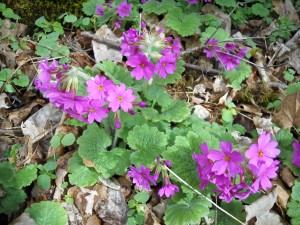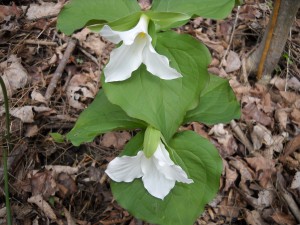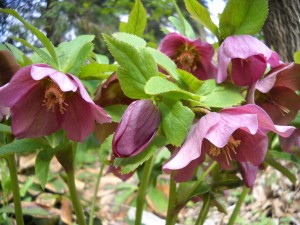Spring Flowers
I love spring. Winter is relatively austere time in the garden so I relish the bounty of spring all the more. Over the years I have tried growing most flowers that will provide color in March, April and May. Below are some of my favorites.
First to bloom are the bulb flowers that begin the spring show in March. I have thousands of snowdrops (Galanathus elwesii), squill (Scilla siberica), glory of the snow (Chionodoxa luciliae). These are followed in April by crocus, daffodils and early tulips. I cut even the smallest blossoms to bring inside and place on the kitchen counter in a vase. Almost all the bulb plants are good cut flowers. I plant bulb plants every fall, and recommend top-dressing them with organic fertilizer after they finish blooming each spring.
Then come the early perennials, starting in April and continuing on into May. One of the first, and easiest to grow, is called lungwort. The unattractive name comes from the leaves, which some unfortunate person decided looked like lungs – complete with spots on most varieties. I prefer to call them by their Latin genus, Pulmonaria, which is more melodious.
Pulmonaria will grow in sun or shade, wet or dry. They spread by root, creating large low-growing colonies. I once had a gardening client who considered them invasive, though I do not. If they overstep their welcome, I find they pull fairly easily with my favorite weeding tool, the CobraHead weeder, which gets under them easily. The small flowers come in shades of blue, pink, peach and white. They don’t do well in a vase, so I don’t pick them.
Another spring favorite of mine is the hellebore, sometimes called the Lenten Rose. Hellebores are among the earliest to send up shoots of flowers and hold those flowers for several weeks. Each flower stalk stands 12 to 15 inches tall and supports new leaves and bell-shaped flowers that are rose to purple in color, or sometimes green and white. Like the Pulmonaria, they do not last well in a vase.
Primroses bloom early, and come in a wide range of species and colors. I have at least 6 different species in bloom now. One of my favorites has no common name, only going by its scientific name, Primula kisoana. Because its species name starts with “kis”, you can call it the kissing primrose – even if no one else does (except me). It has bright magenta-colored flowers that stand just a few inches above the light-green leaves. It is not very well known at nurseries; I found mine at Cider Hill Gardens in Windsor, VT (www.ciderhillgardens.com).
An endearing quality of Primula kisoana is that it spreads by root – but never runs over another plant to establish new territory. Primroses, in general, are form clumps but spread by seed. Some, like the candelabra primrose (Primula japonica) spread very vigorously by seed if the conditions are right for it. That one stands up over two-feet tall, but blooms much later, usually in June. But P. kisoana spreads fast if the soil conditions are right. One plant can grow to cover 1 to 2 square feet in a season. They like rich, dark soil with a slightly acidic pH.
 Most primroses grow well in light shade or morning sunshine and prefer moist soil. Primula kisoana, on the other hand, will grow in dry soil, too. I have observed that one of the best places to grow any primrose is under an old apple tree. The soil and light there generally is perfect for primroses.
Most primroses grow well in light shade or morning sunshine and prefer moist soil. Primula kisoana, on the other hand, will grow in dry soil, too. I have observed that one of the best places to grow any primrose is under an old apple tree. The soil and light there generally is perfect for primroses.
Although it is contrary to the law to dig up wildflowers and transplant them to your property, many good garden centers are now propagating and selling them. In nature, most spring wildflowers grow in the dappled shade of a hardwood forest. They send up flowers and leaves before the trees have leafed out, and disappear soon after the forest becomes shady. Among my favorites are the trilliums, bloodroot, and hepaticas – though there are dozens of other species.
Bloodroot are so named for the red juice that oozes from the roots if cut. I’ve read that Indians used it for dye. The leaves come up wrapped like a cigar around the flower stalk. Each simple white flower stands 6 inches tall. The blossoms open on warm, sunny days and close up at night or on chilly days. They spread by root to form nice clumps. I also have some double bloodroot – the flowers resemble small white double peonies. The flowers are probably sterile, as they keep on blooming much longer than the singles. Most flowers stop blooming once fertilized, having done their work.
I have three species of trillium: the ordinary maroon one (Trillium erectum), the white one (Trillium grandiflorum) and the yellow one (Trillium luteum). All will grow in light shade or part sun and prefer rich, dark soil. The New England Wildflower Society (www.newfs.org) sells all three – and many other fine wildflowers at their headquarters, The Garden in the Woods in Framingham, MA. I bought my yellow trillium from them. In addition to its flower, it has handsome mottled leaves.
So visit your local garden center soon to see what early spring bloomers they offer, and try something new. You’ll be glad you did.
Henry Homeyer is a gardening consultant and the author of 4 gardening books. His Web site is www.Gardening-Guy.com.





